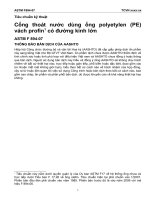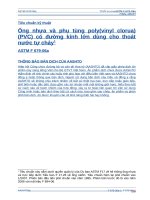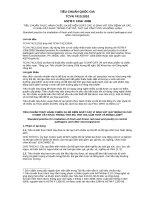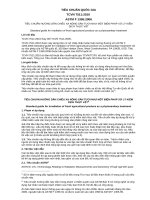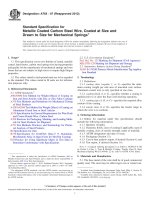Astm f 2674 07
Bạn đang xem bản rút gọn của tài liệu. Xem và tải ngay bản đầy đủ của tài liệu tại đây (84.93 KB, 5 trang )
Designation: F 2674 – 07
Standard Specification for
Zinc Coating, Hot-Dip, Requirements for Application to
Carbon and Alloy Steel Bolts, Screws, Washers, Nuts, and
Special Threaded Fasteners [Metric]1
This standard is issued under the fixed designation F 2674; the number immediately following the designation indicates the year of
original adoption or, in the case of revision, the year of last revision. A number in parentheses indicates the year of last reapproval. A
superscript epsilon (e) indicates an editorial change since the last revision or reapproval.
F 606M Test Methods for Determining the Mechanical
Properties of Externally and Internally Threaded Fasteners,
Washers, and Rivets [Metric]
F 1470 Guide for Fastener Sampling for Specified Mechanical Properties and Performance Inspection
F 1789 Terminology for F16 Mechanical Fasteners
F 2329 Specification for Zinc Coating, Hot-Dip, Requirements for Application to Carbon and Alloy Steel Bolts,
Screws, Washers, Nuts, and Special Threaded Fasteners
1. Scope
1.1 This specification covers the requirements for hot-dip
zinc coating applied to carbon steel and alloy steel bolts,
screws, washers, nuts, and special threaded fasteners applied
by the hot-dip coating process that are manufactured in SI units
(metric). Nails and rivets are not included in this specification.
NOTE 1—This specification is the metric companion of Specification
F 2329.
1.2 This specification is intended to be applicable to fasteners that are centrifuged or otherwise handled to remove excess
galvanizing bath metal (free zinc).
1.3 The values stated in SI units are to be regarded as
standard. No other units of measurement are included in this
standard.
1.4 This standard does not purport to address all of the
safety concerns, if any, associated with its use. It is the
responsibility of the user of this standard to establish appropriate safety and health practices and determine the applicability of regulatory limitations prior to use.
3. Terminology
3.1 Terms used in this specification are defined in Terminology F 1789 unless otherwise defined in this specification.
3.2 Definitions of Terms Specific to This Standard:
3.3 batch lot—quantity of identical parts cleaned, pickled,
fluxed, and galvanized together at one time in a galvanizing
basket.
3.4 galvanizing—hot-dip zinc coating.
3.5 high temperature galvanizing—galvanizing process carried out in a ceramic vessel (kettle) at an approximate
temperature ranging between 530 and 560 °C.
3.6 hot-dip zinc coating of mechanical fasteners—process
whereby fasteners are zinc coated by immersion in a bath of
molten zinc, resulting in the formation of the iron/zinc alloy
coating and a zinc coating at the surface of the fastener. This
process involves the removal of excess zinc by spinning the
parts in a centrifuge, or brushing the threaded portion, or
handling otherwise to remove the excess zinc.
3.7 production lot—batches of parts originating from the
same manufacturing lot, processed continuously through cleaning, pickling, fluxing, dipping in molten zinc and spun in a
centrifuge, or other means, without any significant change in
time, temperature, and concentration of the constituents of the
process.
3.8 stress relief—process of heating parts for a definite time
at a given temperature in order to relieve stress induced by
work hardening.
2. Referenced Documents
2.1 ASTM Standards: 2
A 153/A 153M Specification for Zinc Coating (Hot-Dip) on
Iron and Steel Hardware
A 563M Specification for Carbon and Alloy Steel Nuts
[Metric]
B 487 Test Method for Measurement of Metal and Oxide
Coating Thickness by Microscopical Examination of Cross
Section
E 376 Practice for Measuring Coating Thickness by
Magnetic-Field or Eddy-Current (Electromagnetic) Examination Methods
1
This test method is under the jurisdiction of ASTM Committee F16 on
Fasteners and is the direct responsibility of Subcommittee F16.03 on Coatings on
Fasteners.
Current edition approved Dec. 1, 2007. Published January 2008.
2
For referenced ASTM standards, visit the ASTM website, www.astm.org, or
contact ASTM Customer Service at For Annual Book of ASTM
Standards volume information, refer to the standard’s Document Summary page on
the ASTM website.
4. Ordering Information
4.1 Orders for zinc coating of fasteners to this specification
shall include the following:
Copyright © ASTM International, 100 Barr Harbor Drive, PO Box C700, West Conshohocken, PA 19428-2959, United States.
1
F 2674 – 07
4.1.1 Name of product (that is, bolt, stud, nut, washers, or
other);
4.1.2 ASTM designation and year of issue, including fastener specification number;
4.1.3 Hydrogen embrittlement relief, as required by the
purchaser, see 7.2.3;
4.1.4 Quantity of fasteners to be hot-dip zinc coated;
4.1.5 Stress relief or tempering temperature to which the
fasteners were subjected, if applicable;
4.1.6 Secondary processing such as chromating, phosphating, or lubrication, if applicable;
4.1.7 Average galvanizing temperature to which fasteners
will be subjected, if required by the purchaser (see 7.2.2);
4.1.8 Specify baking if required (see 7.2.3); and
4.1.9 Certification, if required (see 14.1).
NOTE 2—The scope of this specification does not cover the requirements regarding the overtapping of galvanized nuts. These requirements
are established by the applicable product standard, such as Specification
A 563M (or others), or in writing by the purchaser, if needed.
5.5 Secondary Processing:
5.5.1 When requested by the purchaser, treatments such as
chromating or phosphating shall be applied to reduce the
possibility of wet storage staining (white corrosion) or to assist
subsequent painting.
5.5.2 When specified on the purchase order, the nuts, bolts,
or screws shall be lubricated to enhance assembly.
6. Chemical Composition of Zinc
6.1 Unless otherwise specified in the product standard, the
zinc used for the coating shall conform to the requirements of
the section on Zinc of Specification A 153/A 153M.
5. Materials and Manufacture
5.1 Condition of the As-Received Fasteners—The fasteners
as received by the galvanizer shall be free from contaminants
that are not readily removed in the cleaning process and would
adversely affect the galvanizing.
5.2 Process—Unless otherwise covered in this specification, all processing parameters shall be in accordance with the
requirements of Specification A 153/A 153M.
5.2.1 Process Control—Galvanized fasteners subjected to a
process control plan based upon batch lot level shall comply
with the batch lot sampling plan in Table 1, and the sampling
plan for production lot (prevention process) as determined in
10.2.2 shall be applied.
5.3 Spinning and Quenching:
5.3.1 Parts shall be spun immediately following removal
from the galvanizing bath and quenched in water. In addition,
small parts shall be air cooled as needed in order to prevent the
formation of zinc oxide.
5.3.2 Parts, which cannot be spun shall be brushed or
handled otherwise to remove the excess zinc.
5.4 Alteration of Threaded Fasteners:
5.4.1 Fasteners that have been hot-dip galvanized shall not
be further altered (such as subjected to a cutting, rolling,
finishing-tool operation) by the galvanizer unless specifically
authorized in writing by the purchaser.
5.4.2 Hot-dip galvanizing of externally threaded fasteners
shall meet the thread fitting requirements of the specified
product standard or specific allowance as determined by the
customer.
7. Safeguards Against Alteration of Fasteners Mechanical
Properties
7.1 Stress Relief—Fasteners subjected to severe work hardening shall be stress-relieved by the fastener manufacturer
prior to hot-dip zinc coating (galvanizing).
7.2 Hot-Dip Zinc Coating:
7.2.1 Effect of Temperature on Mechanical Properties:
7.2.1.1 Galvanizing carried out at a temperature above
425 °C can adversely affect the final mechanical properties of
the fasteners. Therefore, the supplier of the fasteners submitting the product to the galvanizer shall be aware of the
tempering temperature of the fasteners relative to the temperature of the galvanizing bath and the potential effect it may have
on the product. When requested by the purchaser, the average
galvanizing temperature that the fasteners shall be subjected to
shall be furnished.
7.2.1.2 Unless otherwise required by the product standard or
by the purchaser, testing for mechanical properties is not
necessary if the galvanizing process is carried out at a lower
temperature than the stress relief or tempering temperature of
the fasteners. If the galvanizing process is carried out at a
higher temperature than the stress relief or the tempering
temperature of the fasteners, than the purchaser shall make
provision for mechanical testing.
7.2.1.3 Threaded fasteners made from carbon or alloy steel
heat treated to the specified hardness of 40 HRC or above, or
case hardened steel fasteners, or fasteners made to specifications which forbids zinc coatings shall not be hot-dip zinc
coated.
7.2.2 Effect of Hydrogen on the Mechanical Properties after
Galvanizing—Hydrogen has the potential of being introduced
into the steel during acid pickling, prior to hot-dip galvanizing.
For high strength fasteners (having a specified minimum
product hardness of 33 HRC), there is a risk of internal
hydrogen embrittlement. If required by the product standard or
by the purchaser, mechanical descaling (with or without flash
pickling) or baking shall be conducted to reduce the risk of
internal hydrogen embrittlement. Baking shall be conducted
after pickling and prior to hot-dip galvanizing.
7.2.3 Effect of the Galvanizing Temperature—Externally
threaded ferrous larger than M24 with a specified minimum
TABLE 1 Process Control of Batch LotA
Sample SizeB
Batch
Lot
Size
5 to 25
26 to 50
51 to 150
151 and over
Average Coating
ThicknessC
Adhesion
AppearanceD
1
1
2
2
1
1
1
2
1
2
2
2
A
The acceptance criterion in all cases is zero defects.
The sample size is the number of specimen(s) required to be tested/inspected.
C
Coating thickness frequency of measurements: one set of specimen(s) for
every five batch lots. For test method see 1.1
D
Visual inspection for conformance.
B
2
F 2674 – 07
that is related to the uncoated surface condition of the part,
shall not constitute grounds for rejection of the parts.
9.2.2 The test method shall be in accordance with 11.3.
hardness of HRC 33 and higher shall not be hot-dip zinc coated
at high temperature in order to avoid microcracks
8. Coating and Dimensional Requirements
8.1 Coating Thickness—The zinc coating thickness shall
meet the requirements of Table 2.
8.2 The dimensional characteristics of the fasteners shall be
in accordance with the requirements of the purchaser, when
specified in the order. The purchaser shall ensure that the effect
of the heat generated by the galvanizing process is compatible
with the fastener regarding the final dimensional characteristics
of the parts. Furthermore, the galvanizer shall not be held
responsible for any unanticipated distortion of parts. In addition, the purchaser shall provide fasteners having sufficient
dimensional allowance to accommodate the zinc thickness
deposition, as required in 8.1.
8.3 The zinc coating shall adhere tenaciously to the surface
of the base metal. The method for testing the condition of
adherence is specified in 11.5.
10. Sampling
10.1 Test specimens shall be selected at random from each
production lot or batch lot, when applicable.
10.2 Selection of the Sampling Plan–Production Lot—Two
sampling plans are proposed, one based on detection process
and one based on prevention process as defined in Terminology
F 1789. The selection of the sampling plan shall be in accordance with Guide F 1470.
10.2.1 Production Lot–Detection Process—Sampling for
coating thickness and for visual appearance shall be conducted
in accordance with Table 1, Sample Level A, and Table 3,
Sample Size A, of Guide F 1470. Sampling for adhesion test
shall be in accordance with Table 1, Sample Level C, and
Table 3, Sample Size C, of Guide F 1470.
10.2.2 Production Lot–Prevention Process—Sampling for
coating thickness and for visual appearance shall be conducted
in accordance with Table 2, Sample Level B, and Table 3
Sample Size B, of Guide F 1470. Sampling for adhesion test
shall be in accordance with Table 2, Sample Level D, and
Table 3, Sample Size D, of Guide F 1470.
9. Workmanship Finish and Appearance
9.1 Appearance of Zinc Coating:
9.1.1 After hot-dip galvanizing, fasteners shall meet the
requirements of the section on Workmanship, Finish, and
Appearance of Specification A 153/A 153M. Galvanized washers shall not be bonded to each other (see Note 3). Parts may
be dull due to the presence of silicon in the steel. The dull
appearance shall not be cause for rejection.
11. Test Methods
11.1 Tests shall be made to ensure that the zinc coating is
being furnished in accordance with this specification and as
specified for the following:
11.2 Coating Thickness :
11.2.1 Average Coating Thickness on an Individual Specimen:
11.2.1.1 To calculate the average coating thickness of one
specimen, a minimum of five readings shall be taken. In case
the geometry of the specimen does not permit five readings,
five test specimens shall be used to establish the average
reading.
11.2.1.2 The determination of the coating thickness shall be
made on a portion of the fastener that does not include any
threads in accordance with Practice E 376.
NOTE 3—Hot-dip washers tend to bond to each other. Suitable acceptance criteria shall be agreed between the purchaser and the galvanizer
before placing the order. Unless otherwise agreed to in the purchase order,
delivered galvanized washers shall not be bonded to each other.
9.1.2 The test method shall be in accordance with 11.3.
9.2 Smoothness of Zinc Coating:
9.2.1 The zinc coating shall be smooth and reasonably
uniform in thickness, as defined in the section on Workmanship, Finish, and Appearance of Specification A 153/A 153M.
Smoothness of a surface is a relative term. Minor roughness
that does not impair the intended use of the part, or roughness
TABLE 2 Zinc Coating Thickness
Minimum Thickness on Surface
DimensionA
Fasteners with a
diameter larger than M8
Washers 470 mm to 660 mm
in thickness
Fasteners with a
diameter up to M8
Washers under 470 mm
in thickness
Average Thickness of
All Specimens Tested
(Production Lot)B
Average Thickness of
All Specimens Tested
(Batch Lot )C
Average Thickness of
Individual Specimens
50 µm
43 µm
43 µm
43 µm
38 µm
38 µm
A
In the case of long pieces, such as anchor rods and similar articles over 1.5 m length, the thickness measurement shall be determined at each end and the middle
of the article. In the case of a fully threaded rod, the thickness measurements shall be determined at each end of the article. In no case shall the average of the
measurements be below the average thickness shown in the Average Thickness on individual Specimen column (see 11.2). The number of specimens to be tested per
order shall be as specified in Section 10. Note—Based upon mathematical calculations, 305 g/m2 of zinc surface corresponds to an average coating thickness of 43 µm.
B
For test method, see 11.2. In no case shall the average reading of a single specimen be below the average thickness shown in the Average Thickness on Individual
Specimen column
C
See 5.2.1 and Table 1. For test method, see 11.2. In no case shall the average reading of a single specimen be below the average thickness shown in the Average
Thickness on Individual Specimen column.
3
F 2674 – 07
13. Rejection and Rehearing
11.2.1.3 In case of arbitration, the thickness of coating shall
be determined by cross section and optical measurement, in
accordance with Test Method B 487. Thus, the thickness
determined is a point value. No less than five measurements
shall be made at locations on the test specimen, which are as
widely dispersed as practical, so as to be representative of the
whole surface of the test specimen. The average of those
selected measurements is the average coating thickness.
11.3 Finish and Appearance—Finish and appearance shall
be visually inspected.
11.4 Embrittlement Test—If the product standard requires
testing for hydrogen embrittlement of galvanized fasteners,
testing shall be done in accordance with Test Methods F 606M
or other test method(s), as required by the purchaser.
11.5 Adhesion Test—Testing for adherence shall be conducted as determined in the section on Adherence of Specification A 153/A 153M.
13.1 When partial inspection of fasteners to determine
conformity with visual requirements of Section 9 warrants
rejection of a lot, the galvanizer may sort the lot and submit it
once again for inspection.
13.2 Disposition of nonconforming lots shall be in accordance with the section on Disposition of Nonconforming Lots
of Guide F 1470.
13.3 Fasteners that have been rejected for reasons other
than embrittlement may be stripped and re-galvanized and
submitted for test and inspection. They shall then conform to
the requirements of this specification.
14. Certification
14.1 When specified in the purchase order or contract,
certification shall be furnished declaring that samples representing each lot have been either tested or inspected, as
required by this specification, and that the requirements have
been met. When specified in the purchase order or contract, the
average galvanizing temperature shall be reported and the
average thickness of the production lot shall be furnished.
12. Inspection
12.1 When dimensional inspection of the fasteners by the
galvanizer is required by the purchaser in the order, the
purchaser shall provide the necessary inspection tools and
gages to the galvanizer.
12.2 The representative of the purchaser shall have access at
all times while work on the contract of the purchaser is being
performed, to those areas of the galvanizer’s work which
concern the application of the zinc coating to the fastener
ordered. The manufacturer shall afford the representative of the
purchaser all reasonable facilities to satisfy him that the zinc
coating is being furnished in accordance with this specification.
All inspections and tests shall be made at the place of
manufacture prior to shipments, unless otherwise specified, and
shall be conducted so as not to unnecessarily interfere with the
operation of the works.
15. Product Marking
15.1 When the galvanizer is required to pack hot-dip galvanized fasteners, they should not be packed in unventilated
containers, if fabricated from unseasoned wood. The packaging
shall comply with the purchaser requirements.
16. Keywords
16.1 coatings, zinc; galvanized coatings; steel fastener products, metallic coated; steel zinc coated; zinc coating fastener
products
APPENDIXES
(Nonmandatory Information)
X1. GALVANIZING TEMPERATURE
X1.1 Normally galvanizing is carried out at a bath temperature of 435°C to 480°C. High temperature galvanizing is used
to produce a smoother and thinner coating and is carried out at
a bath temperature of 530°C to 560°C. The finish obtained
using the high temperature process is dull.
X2. VARIATION IN COATING
X2.1 During galvanizing of a production lot, variation can be
experienced due to factors inherent to the galvanizing process,
such as immersion time, zinc temperature, time span between
removal of fasteners from the zinc bath and the centrifuging,
and the like.
4
F 2674 – 07
ASTM International takes no position respecting the validity of any patent rights asserted in connection with any item mentioned
in this standard. Users of this standard are expressly advised that determination of the validity of any such patent rights, and the risk
of infringement of such rights, are entirely their own responsibility.
This standard is subject to revision at any time by the responsible technical committee and must be reviewed every five years and
if not revised, either reapproved or withdrawn. Your comments are invited either for revision of this standard or for additional standards
and should be addressed to ASTM International Headquarters. Your comments will receive careful consideration at a meeting of the
responsible technical committee, which you may attend. If you feel that your comments have not received a fair hearing you should
make your views known to the ASTM Committee on Standards, at the address shown below.
This standard is copyrighted by ASTM International, 100 Barr Harbor Drive, PO Box C700, West Conshohocken, PA 19428-2959,
United States. Individual reprints (single or multiple copies) of this standard may be obtained by contacting ASTM at the above
address or at 610-832-9585 (phone), 610-832-9555 (fax), or (e-mail); or through the ASTM website
(www.astm.org).
5

